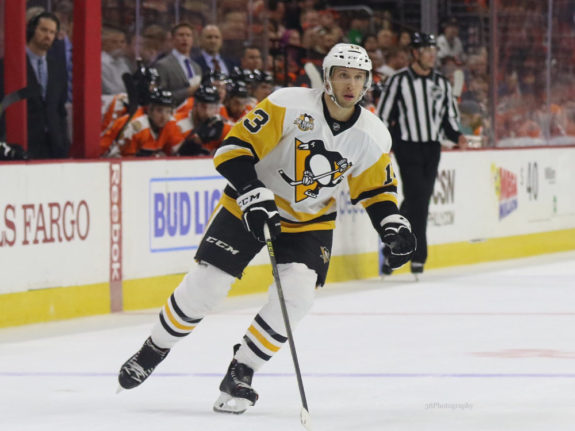The reigning Stanley Cup champion Pittsburgh Penguins owe a lot of their success last June to their third line. This lovingly nicknamed HBK line was composed of Carl Hagelin, Nick Bonino and Phil Kessel. Hagelin (16 playoff points), Bonino (18 points) and Kessel (22 points) combined during the postseason to become the highest-producing line on the champion team. Custom-made HBK jerseys were printed; Shawn Michaels, the original HBK, joined in on the phenomenon on Twitter.
The HBK line was the talk of the playoffs. What has happened to them in the regular season? Why have they fallen off the radar? What has happened to their production numbers, and what will result from this change?
HBK by the Stats
During the 2016 Stanley Cup playoffs, the HBK line contributed hugely to the Penguins’ offense. When on the ice together, they scored a total of 15 goals in only 24 games. That means that they were responsible for about one-fifth of the Penguins’ total playoffs goals. They were the highest-producing line of any playoff team that year, and certainly the highest-producing of any Penguins combination.
Can confirm: HBK chants were ringing throughout SAP Center when this photo was taken. pic.twitter.com/q3cbZODxiy
— Pittsburgh Penguins (@penguins) June 13, 2016
So far this season, when on the ice together, the line has produced only five goals in 52 games. That’s about three percent of the Penguins’ goals so far this season.
How did the HBK line go from an average of 0.625 goals per game during the playoffs to about 0.01 per game during the following regular season? Part of the reason is that they haven’t seen as much ice time together during the regular season. The more pervasive reason is that they simply lack the chemistry they once had.
Playoffs vs. Regular Season
From the very beginning of the season, the HBK line hasn’t been the same combination that we saw dominating the playoffs. It quickly became clear that, unlike in the postseason, this was not going to be the combination the Penguins would rely on for scoring. The line lacked the chemistry that had made them so deadly last summer. Failing to maintain their high numbers of production as the season began, they became the first line to shuffle apart when there were injuries in other areas of the Penguins’ offense. For example, Hagelin had been playing on Carter Rowney’s wing, not Bonino’s, for the last few games before he was diagnosed with a concussion after a bad hit.
The problem isn’t lack of individual production. Kessel has 50 points on the season (only four behind Evgeni Malkin). The difference is that he has gotten the vast majority of these points on a line without Bonino and Hagelin. Despite their extraordinary performance in the last postseason, the combination never quite clicked in the regular season.
Implications of the HBK Changes
The line member most impacted by HBK’s lack of production might be Bonino. Hagelin and Kessel are both signed with the Penguins for the next few seasons (Hagelin to the 2018-19 season and Kessel to 2021-22). In contrast, Bonino becomes an unrestricted free agent at the end of this season. At a $1.9 million cap hit, trading him could free up significant cap space for the Penguins. This is especially significant for a team currently looking to add an experienced defenseman to its roster. Perhaps the failure of the HBK line to maintain momentum in the regular season will factor into the decision of whether or not to sign Bonino.

In addition to finding a new defenseman, the Penguins still need to re-sign Conor Sheary, who is currently set to become a restricted free agent at the end of this season. Sheary, who this season has 35 points to Bonino’s 21, currently takes up a cap hit of under $700,000. He will almost certainly be seeing a raise if the Penguins sign him after this season. Perhaps the extra cap space will come from other roster-shuffling, but Bonino could be a prime candidate for the extra money to keep Sheary.
The reason the Penguins made it through the playoffs last year was because of their significant depth. It wasn’t just the Penguins’ first line opponents had to match; it was their formidable second and third lines as well. With the HBK line not clicking like it used to, head coach Mike Sullivan will have to search for other combinations to recreate this crucial depth in the structure of the lineup.